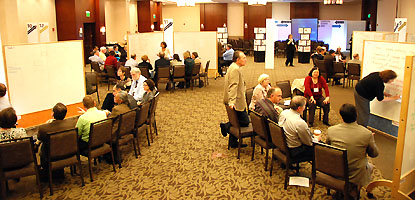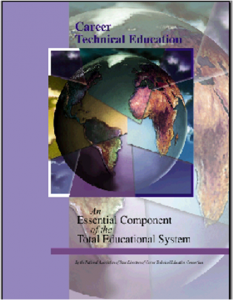I was at a meeting earlier this week when someone asked me about a “super-double-top-secret-meeting†NASDCTEc convened last week in Baltimore. I had to laugh. While the event we hosted was in no way secret, it was, by necessity, by invitation only. This question made me realize the criticality of sharing information about the event we convened. So, this is the first in a series of posts where I will share with you information and insights about the Fall Summit we convened October 20 – 22, 2009 entitled “Future Directions for CTE.â€
Why a S ummit?   CTE is at a critical juncture. Many policymakers, national organizations and leaders are looking to CTE to be a partner and a solution in both the educational and workforce arenas. This recent interest has created an opportunity for us to challenge current beliefs and assumptions, break down silos, broaden perspectives, increase rigor and build systemic support for CTE.
ummit?   CTE is at a critical juncture. Many policymakers, national organizations and leaders are looking to CTE to be a partner and a solution in both the educational and workforce arenas. This recent interest has created an opportunity for us to challenge current beliefs and assumptions, break down silos, broaden perspectives, increase rigor and build systemic support for CTE.
Our organization’s vision statement is that we are the leader in shaping the future of CTE. As such, our Board of Directors felt this was the right time to host an event designed to convene the states in crafting a shared vision for the future of CTE.
Â
Summit ≠Conference: The Summit was not a traditional conference. There were no formal speakers. There was no set agenda. There was no head table or stage. We used a fabulous convening group called Innovation Labs to facilitate this interactive, iterative process and event. Their design creates an atmosphere and environment that facilitates open, honest and active engagement of attendees. Here is what it looks like in action:

The Summit was structured to engage attendees to think about what CTE is, as well as give attendees license to dream about what CTE could and should be. With the backdrop of a couple of webinars and some pre-summit briefing materials, attendees were asked to challenge current assumptions and beliefs. Activities were designed to facilitate not just “outside the box†conversations but instead to have conversations that resulted in creating an entirely new box. We hoped that attendees would come to some amount of consensus and affirm what CTE is (and what it is not), as well as think boldly and broadly about what the future of CTE should be. Our Board’s goal was that the Summit would result in a set of guiding principles that states would embrace and would use to guide both their and NASDCTEc’s work as we provide leadership for the CTE enterprise.
While this may seem like a lofty goal, it is not without precedent. In the 1998, under the leadership of Dr. Mike Rush (who was then the State Director in Idaho) NASDCTEc put out an epochal document – CTE: An Essential Component of the Total Educational System. This paper (informally and affectionately called the ‘purple paper’) paved new ground for us. It defined a new, bold vision for CTE that opened the door for our organization’s work in career clusters. And even more amazing is that all states came to consensus on the 5 principles incorporated into this document. The states agreed to support this as the vision of what CTE is and should be. This consensus and unity among the states provided significant strength and leverage that has resulted in great advances in a very short timeframe.
this may seem like a lofty goal, it is not without precedent. In the 1998, under the leadership of Dr. Mike Rush (who was then the State Director in Idaho) NASDCTEc put out an epochal document – CTE: An Essential Component of the Total Educational System. This paper (informally and affectionately called the ‘purple paper’) paved new ground for us. It defined a new, bold vision for CTE that opened the door for our organization’s work in career clusters. And even more amazing is that all states came to consensus on the 5 principles incorporated into this document. The states agreed to support this as the vision of what CTE is and should be. This consensus and unity among the states provided significant strength and leverage that has resulted in great advances in a very short timeframe.
I believe it is these advances played a significant role in creating the interest, support and opportunities before CTE today. Stakeholders didn’t dismiss CTE as simply relabeled vocational education. Instead stakeholders saw the significant efforts and investments being made by CTE leaders to adopt higher and more rigorous academic and technical standards, to implement systems of accountability, and the shift in attitudes to acknowledge that most students would need some postsecondary education to be prepared for the modern workplace. Further the movement toward career clusters reflected a major shift in the scope of what CTE is, beginning to erode the lines of the tracks for those kids going to college and those going to work.
All told, all but 5 states were represented at last week’s Summit. And among the many states present, attendees included state directors of secondary and postsecondary CTE as well as a small group partners representing the federal government, principals, teachers, governors, CTSOs, colleges and school systems, and business and industry who were dedicated to crafting this new, bold vision for CTE.
So what were the outcomes? Did we achieve consensus? Who was the special guest that kicked off the Summit? You’ll have to read the next installment in this series to get these answers.


